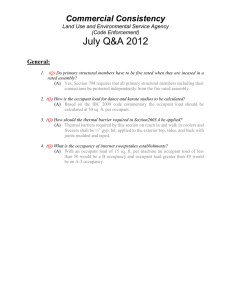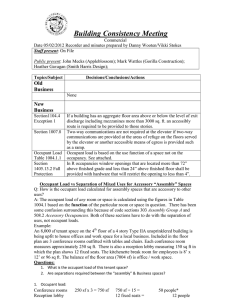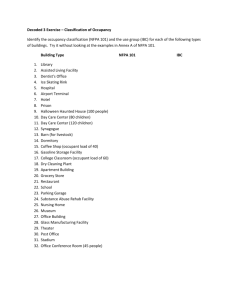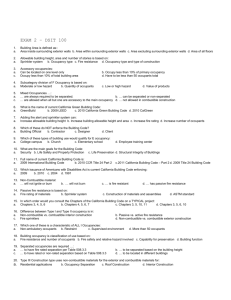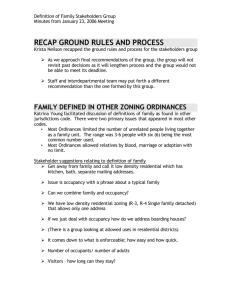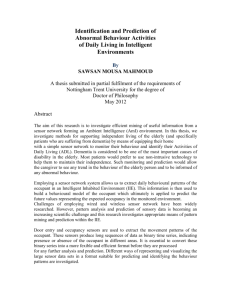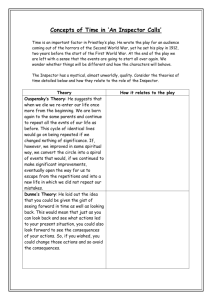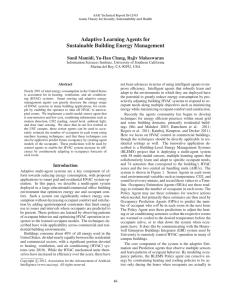user guide for the completion of a fire safety plan
advertisement
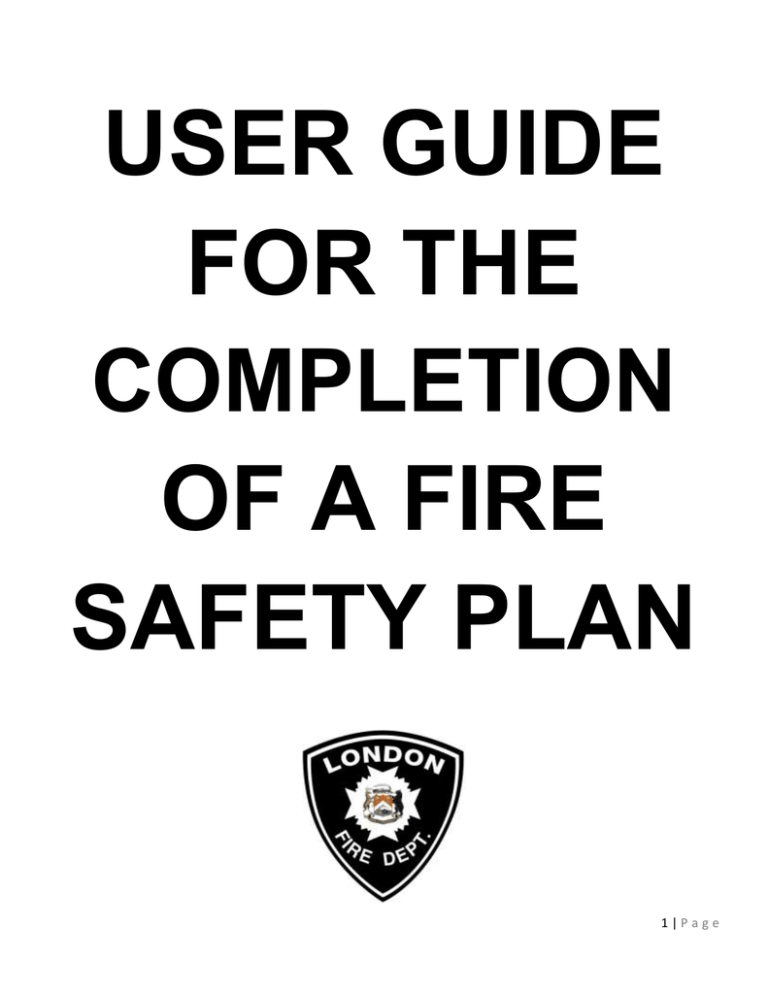
USER GUIDE FOR THE COMPLETION OF A FIRE SAFETY PLAN 1|Page Once your Fire Safety Plan has been completed you need to send it to the Chief Fire Official for review and approval. If you are sending your plan by regular mail you need to mail 2 copies to the address below: Chief Fire Official Fire Prevention Division London Fire Department 400 Horton Street East London, ON N6B 1L7 If you are sending by fax you need to send it to the Fax number below: 1-519-661-8419 If you are sending by E-Mail you need to send it to the e-mail address below: fireforms@london.ca Once your plan is completed it must be reviewed at least annually and if the plan changes it must be re-submitted to the Fire Prevention Division for approval. 2|Page Introduction In this guide you will find the information that you need to assist you in the completion of your fire safety plan. If you have any questions while you are completing this Plan please contact your area Fire Prevention Inspector or the London Fire Department Fire Prevention Division at 519-661-2500 extension 4565. You are encouraged to read this guide thoroughly so that you understand the requirements of a Fire Safety Plan for your building. This guide has been designed as a tool to help you build a Fire Safety Plan for your property. The information in this guide will assist you in the development of your Plan. You may be asked by a Fire Prevention Inspector to add additional information that is not included in this guide that is specific to your building. This will help you and your staff to be more compliant with respect to fire safety and protect you, your staff, and the general public in the event of a fire. Fire Safety Plans are required for building that contains one of the following: An assembly occupancy A care occupancy A care and treatment occupancy A detention occupancy A residential occupancy where the occupant load exceeds 10 people A retirement home A business and personal service occupancy where the occupant load exceeds 300 A mercantile occupancy where the occupant load exceeds 300 A high hazard occupancy where the occupant load exceeds 25 A medium hazard occupancy where the occupant load exceeds 100 A low hazard occupancy where the occupant load exceeds 300 A Fire Prevention Inspector can also order a Fire Safety Plan for a building if it does not meet any of the above requirements but in the opinion of the Fire Prevention Inspector a Fire Safety Plan would assist with fire safety for the building. 3|Page What Needs to be Included in your Fire Safety Plan A thorough and complete Fire Safety Plan can be the difference between success and disaster when a fire occurs. The information in your Plan is critical for you, your staff, and the general public to be protected for fire. It also provides critical strategic information to first responders to assist them in mitigating the emergency in a safe and well-coordinated manner. The Ontario Fire Code requires that the following information by in all Fire Safety Plans to ensure the safety of you, your staff, the general public, and first responders: O. Reg. 213/07 as amended Div., B., 2.8.2.1. states that a Fire Safety Plan shall; (1) A Fire Safety Plan shall be prepared, approved and implemented in buildings and premises to which this Section applies. (2) (a) provide for the emergency procedures to be followed in case of fire, including (i) sounding the fire alarm, (ii) notifying the fire department, (iii) instructing occupants on procedures to be followed when the fire alarm sounds, (iv) evacuating occupants, including special provisions for persons requiring assistance, (v) procedures for use of elevators, and (vi) confining, controlling and extinguishing the fire, (b) provide for the appointment and organization of supervisory staff to carry out fire safety duties, (c) provide for the training of supervisory staff and the instruction of other occupants in their responsibilities for fire safety, (d) include documents and diagrams showing the type, location and operation of the building fire emergency systems, (e) provide for the holding of fire drills and set out fire drill procedures, (f) provide for the control of fire hazards in the building, (g) provide for the maintenance of building facilities provided for the safety of occupants, and; (h) provide for alternative measures to be provided for the safety of occupants during a shutdown of any or all fire protection equipment or systems. (3) The fire safety plan shall be kept in the building or premises in an approved location. (4) The fire safety plan shall be reviewed as often as necessary, but at least every 12 months, and shall be revised as necessary so that it takes into account changes in the use or other characteristics of the building or premises. 4|Page (5) Before demolition or construction, including hot surface applications, commences in or on the building or premises, the fire safety plan shall be revised to incorporate (a) temporary alternative measures for the fire safety of the occupants during the demolition or construction, and (b) temporary procedures to control fire hazards associated with the demolition or construction, including procedures to mitigate risks to adjacent buildings. (6) The revised fire safety plan prepared under Sentence (4) or (5) shall be implemented. (7) In the case of a care occupancy, care and treatment occupancy and retirement home, any training of supervisory staff carried out under a fire safety plan shall be recorded. (8) The original or a copy of at least the most recent and the immediately preceding record referred to in Sentence (7) shall be retained in the building for a period of at least two years after being prepared and shall be made available to the Chief Fire Official for examination on request. It is important that all this information be included in your Plan to ensure the safety of you, your staff, the general public, and first responders in the event of a fire. 5|Page How to use this Guide The London Fire Department hopes that this guide will assist you in the development of a Fire Safety Plan for your building. If you have any questions while you are completing this Plan please contact your area Fire Prevention Inspector or the London Fire Department Fire Prevention Division at 519-661-4565. This guide is designed to be user friendly. A Fire Safety Plan requires a significant amount of information in order for it to be a well-developed Plan that is easy to implement should a fire occur. The Fire Safety Plan needs to be broken down into the following sections in order to be successful: Part 1 Part 2 Part 2 Introduction: (a) (b) Building Resources Audit: Human Resources Audit: Part 3 Emergency Procedures — Occupants: Part 4 Emergency Procedures — Supervisors: Part 5 Responsibilities of the Owner/Occupant: Part 6 Part 6 (a) (b) Fire Hazards — Residential: Fire Hazards — Commercial: Part 7 Fire Extinguishment/Control/Confinement: Part 8 Alternative Measures: Part 9 Fire Drills: Part 10 Maintenance Requirements of Building Fire And Life Safety Systems: Part 11 Building Schematics: 6|Page Your Fire Safety Plan shall have a cover page that includes the following information on it; Name of Business or Property Business or Property address The name of the person who prepared the Plan A spot for the Fire Prevention Inspector to sign the plan as a reviewer In addition to these required parts, the Fire Safety Plan needs to have a Table of Contents so that you, your staff, the general public, and first responders have easy and quick access to sections of your Plan in the event of a fire. In an effort to make the process of completing your Fire Safety Plan easier, the London Fire Department has developed a blank “Fire Safety Plan” document, as well as a document, “Information to be included in a Fire Safety Plan”, that contains information that may or may not apply to your building. You only need to copy and paste the information that applies to your building into the blank copy of your “FIRE SAFETY PLAN” EXAMPLE: (See next page) 7|Page Part 2(a) Audit of Building Resources Checklist Occupancy Type Occupant Load Occupant Load: (if applicable) Access Designated Fire Route: No Yes Nearest Municipal Hydrant Location: Private Hydrants: Lockbox: Heating Main Gas Shut-off: No No Yes (Location(s)): Natural Gas No Yes (Location(s)): Electric Other Yes (Location(s)): If you’re building does not have a designated fire route, lockbox, occupant load, or a private hydrant then it does not apply to your building and will look like this for this Part; Part 2(a) Audit of Building Resources Checklist Occupancy Type Access Nearest Municipal Hydrant Location: Private Hydrants: Heating Main Gas Shut-off: No Natural Gas No Yes (Location(s)): Electric Other Yes (Location(s)): 8|Page Each section of the “INFORMATION TO BE INCLUDED IN A FIRE SAFETY PLAN” can be easily copied and pasted into the blank copy of your “FIRE SAFETY PLAN”. The London Fire Department wants to ensure your success with building your Fire Safety Plan, if you have any questions while you are completing your Plan please contact your area Fire Prevention Inspector or the London Fire Department Fire Prevention Division at 519-6614565. 9|Page Completion of Your Fire Safety Plan Once your Fire Safety Plan has been completed you need to send it to the Chief Fire Official for review and approval. If you are sending your plan by regular Mail you need to mail 2 copies to the address below; Chief Fire Official Fire Prevention Division London Fire Department 400 Horton Street East London, ON N6B 1L7 If you are sending by Fax you need to send it to the Fax number below; 1-519-661-8419 If you are sending by E-Mail you need to send it to the e-mail address below; fireforms@london.ca Once your plan is completed it must be reviewed at least annually and if the plan changes it must be re-submitted to the Fire Prevention Division for approval. 10 | P a g e If you have any questions regarding your plan please contact your area Fire Prevention Inspector or the London Fire Department Fire Prevention Division at 519-661-4565. 11 | P a g e
